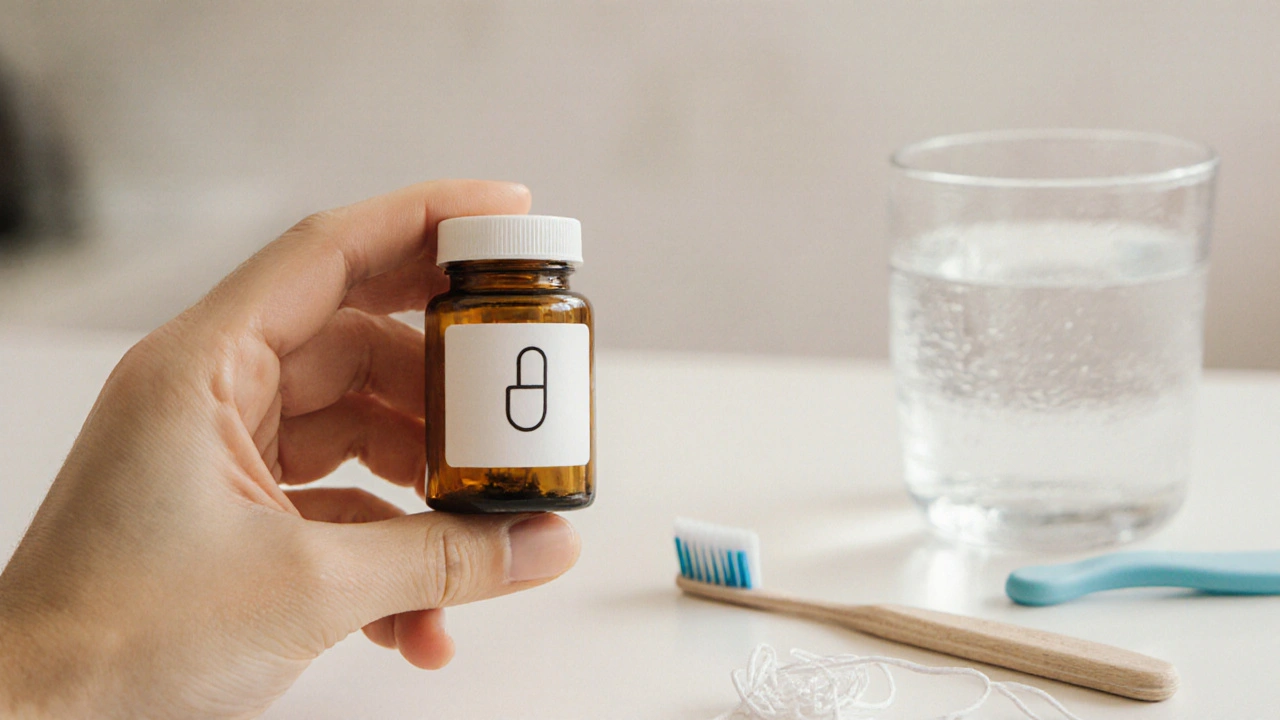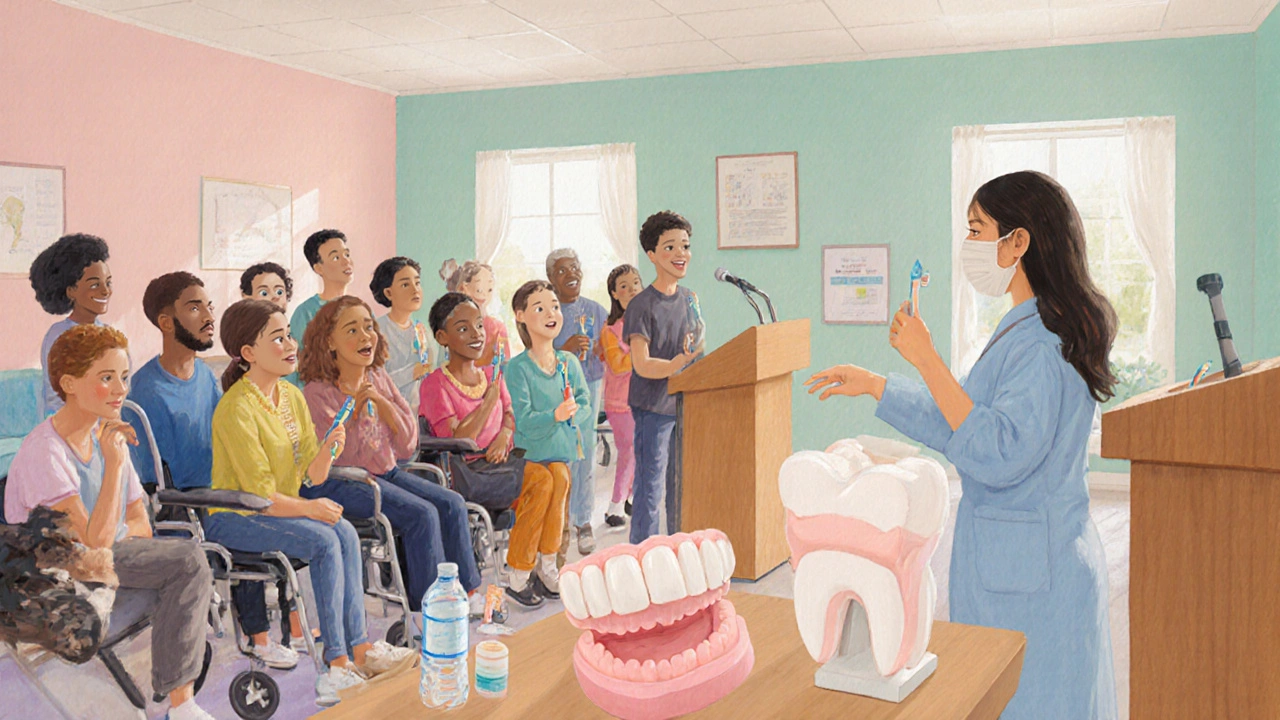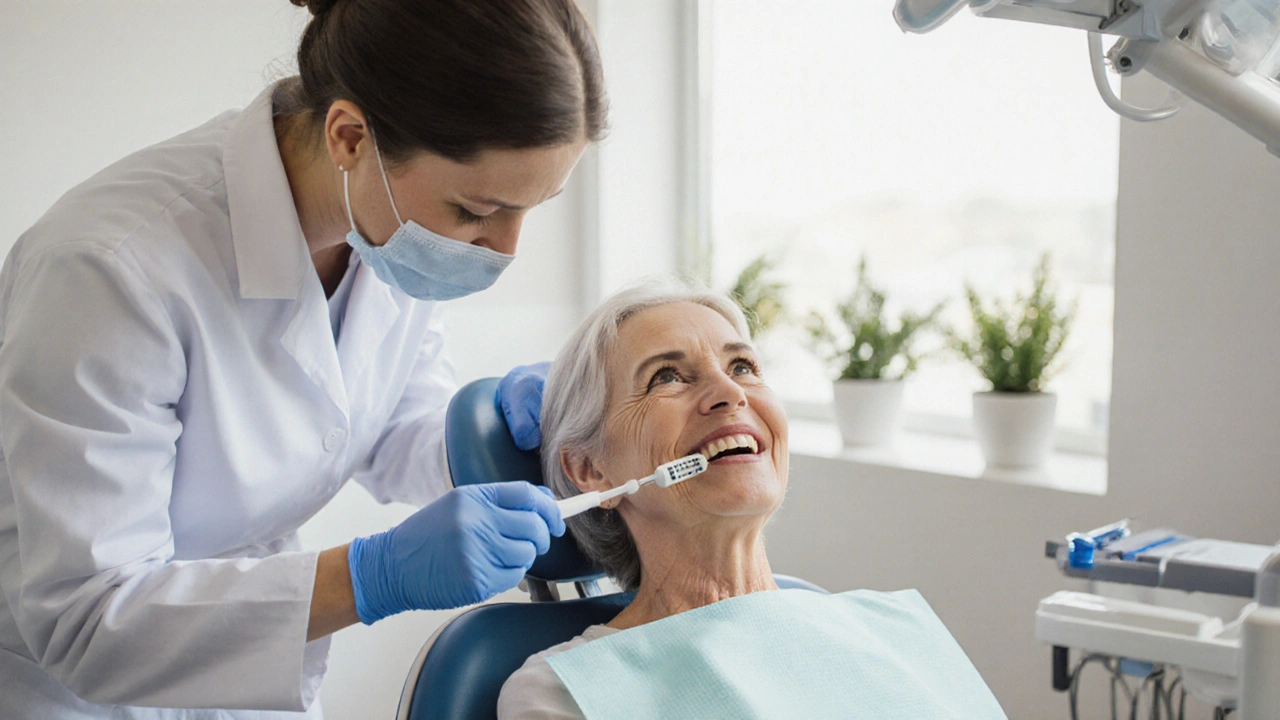MG Dental Appointment Planner
Plan your ideal dental appointment time based on your medication schedule and energy levels.
Recommended Appointment Time:
Living with Myasthenia Gravis is a daily balancing act, and your teeth shouldn’t be the part that tips the scale. Myasthenia Gravis dental care isn’t just about brushing; it’s about tweaking habits, talking to your dentist, and watching the side‑effects of the medicines that keep your muscles humming.
Quick Takeaways
- Schedule dental visits early in the day when energy levels are highest.
- Tell your dentist about every MG medication you take.
- Combat dry mouth with sugar‑free gum, water, and saliva substitutes.
- Prefer soft‑bristled brushes and gentle techniques to avoid fatigue.
- Carry a written emergency plan for any dental procedure.
Understanding Myasthenia Gravis
Myasthenia Gravis is an autoimmune disorder where antibodies block the communication between nerves and muscles. The result? Muscles that tire quickly and recover slowly. While the condition mostly hits the eyes, face, and throat, it can also affect the muscles you use to chew, swallow, and keep your mouth open for a dentist’s chair.
How MG Medications Touch Your Mouth
Most people with MG rely on two drug families: anticholinesterase medications like pyridostigmine and immunosuppressants such as prednisone or azathioprine. These lifesavers can unintentionally dry out your mouth, increase plaque, or raise infection risk.
| Medication | Drug Class | Typical Dose | Oral Side Effects |
|---|---|---|---|
| Pyridostigmine | Anticholinesterase | 60‑120mg/day | Dry mouth, increased caries risk, occasional cramps |
| Prednisone | Glucocorticoid (immunosuppressant) | 5‑20mg/day | Gum thinning, faster plaque growth, mouth sores |
| Azathioprine | Immunosuppressant | 50‑150mg/day | Oral thrush, delayed wound healing |
| Mycophenolate mofetil | Immunosuppressant | 1‑2g/day | Dry mouth, increased infection risk |
Everyday Oral‑Hygiene Tweaks
Standard brushing with a hard‑bristled brush can fatigue facial muscles. Switch to a soft‑bristled toothbrush and use circular motions for 30 seconds, twice a day. An electric brush with a pressure sensor can help you avoid pressing too hard, saving energy for the rest of the day.
- Floss wisely: If hand‑flossing feels exhausting, try floss picks or a water‑flosser set to low pressure.
- Rinse smart: Alcohol‑free, fluoride‑rich mouthwashes soothe the throat and add a protective layer.
- Timing matters: Brush after meals, but if you’re taking pyridostigmine in the morning, wait 30 minutes to let the medication settle before you start.

Combatting Dry Mouth (xerostomia)
Dry mouth is the most common complaint among MG patients on anticholinesterase drugs. Here’s a quick toolkit:
- Sip water every 15‑20 minutes, especially before meals.
- Chew sugar‑free xylitol gum three times a day to stimulate saliva.
- Use over‑the‑counter saliva substitutes-sprays or gels work well before bedtime.
- Avoid caffeine, alcohol, and salty snacks, which worsen dehydration.
- Ask your doctor about pilocarpine if dryness becomes severe; it’s a medication that can boost salivation.
Talking to Your Dentist
Clear communication can prevent mishaps. Hand your dentist a printed list that includes:
- All MG drugs, dosages, and timing.
- Any recent changes in medication.
- History of antibiotic prophylaxis if you’ve had heart valve work or joint replacements.
- Preferred appointment times (morning slots when you’re strongest).
- Emergency contact numbers for your neurologist.
Don’t hesitate to ask the dentist to adjust the chair height or provide a supportive headrest. A well‑positioned patient uses less neck and facial muscle strength, making the visit smoother.
Safe Dental Procedures for MG Patients
Procedures that require the mouth to stay open for long periods-like crown preparations or extractions-need extra planning.
- Local anesthesia: Most MG patients tolerate lidocaine well, but inform the dentist that high‑dose muscle relaxants can interact with certain anesthetics.
- Sedation: Mild oral sedation (e.g., low‑dose diazepam) can be used, but only under neurologist guidance because MG can heighten sensitivity.
- Post‑procedure care: Schedule a follow‑up within 24‑48hours to catch any unexpected swelling or choking risk.
If you ever feel short‑of‑breath or notice rapid fatigue during a visit, signal the dental team immediately. Having a written “Stop” card can be lifesaving.
When to Call for Help
Dental emergencies are more stressful when MG is in the mix. Call your dentist or neurologist right away if you notice:
- Sudden difficulty swallowing (dysphagia) after a procedure.
- Unexplained facial droop lasting more than a few minutes.
- Persistent dry‑mouth‑related sores that don’t heal in a week.
- Any sign of infection-redness, swelling, fever-in the gums or jaw.
Having a small “Emergency Dental Card” with your name, MG diagnosis, medications, and doctor’s contact details fits neatly into a wallet and can speed up care.
Quick Checklist Before Your Next Appointment
- Confirm morning appointment.
- Take your MG meds as prescribed, but wait 30minutes before brushing if using pyridostigmine.
- Pack a water bottle, sugar‑free gum, and your medication list.
- Review any recent medication changes with your neurologist.
- Bring your emergency dental card.

Frequently Asked Questions
Can I get a dental cleaning if I’m on prednisone?
Yes, but schedule it when your dose is stable and tell the hygienist about the steroid. Prednisone can thin gum tissue, so the hygienist may use a gentler technique.
Is it safe to have a tooth extraction under local anesthesia?
Generally safe. The dentist should avoid muscle relaxants that interfere with neuromuscular transmission. A short‑acting local anesthetic like lidocaine is preferred.
What can I do about persistent dry mouth?
Stay hydrated, chew sugar‑free gum, use saliva‑substituting sprays, and discuss pilocarpine or other sialogogues with your doctor.
Do I need antibiotics before a dental cleaning?
Only if you have a heart valve, joint prosthesis, or a history of endocarditis. Otherwise, routine cleanings don’t require prophylactic antibiotics.
How often should I see my dentist?
Aim for a check‑up every six months. If you notice increased cavities or gum issues, move the next visit up to three months.


Comments
Hey there! 🌟 Great rundown-your appointment planner is a lifesaver for anyone juggling meds and energy. 🌈 Remember to keep a small snack handy for low‑energy days; it can keep you steady during the wait. 💪
Scheduling in the morning really does cut down fatigue during the visit.
In the grand tapestry of health, dental care is a quiet thread that holds the smile together; neglecting it can unravel more than just teeth. 😉 Let’s cherish those small rituals as acts of self‑respect.
While poetic, the clinical recommendation remains: prioritize morning appointments when neuromuscular strength peaks.
First, acknowledge that Myasthenia Gravis imposes a delicate balance on the oral ecosystem, demanding both vigilance and compassion; second, the choice of toothbrush matters profoundly-soft‑bristled, electric models with pressure sensors are not merely conveniences but essential safeguards against muscular overexertion; third, flossing, often perceived as a trivial task, can become an arduous endeavor, therefore selecting floss picks or water flossers mitigates fatigue while preserving interdental health; fourth, xerostomia, the relentless dryness induced by anticholinesterase agents, can be battled with frequent sips of water, sugar‑free gum, and saliva substitutes-each intervention acting as a miniature oasis; fifth, dietary considerations should extend beyond sugar avoidance to include balanced calcium intake, fortified dairy alternatives, and reduced acidic beverages that erode enamel; sixth, regular professional cleanings, scheduled in the early hours, capitalize on peak muscular strength and reduce the need for prolonged chair time; seventh, always furnish the dentist with a comprehensive medication list, including dosages and timing, to preempt inadvertent drug interactions; eighth, an emergency dental card, succinct yet thorough, should reside in your wallet, featuring diagnosis, medication names, and neurologist contact-this simple artifact can expedite critical care; ninth, post‑operative instructions merit special attention; for MG patients, short‑term antibiotics may be advisable to curb infection due to immunosuppression; tenth, when using local anesthetics, lidocaine remains the gold standard, yet dosage awareness is pivotal because excessive concentrations could exacerbate neuromuscular blockade; eleventh, if sedation is contemplated, only minimal doses under neurologist supervision are permissible, as heightened sensitivity is a hallmark of MG; twelfth, the oral mucosa, often overlooked, requires gentle examination for signs of candidiasis, especially in patients on azathioprine or mycophenolate; thirteenth, saliva‑stimulating agents such as pilocarpine may be introduced after thorough evaluation, offering relief from chronic dryness; fourteenth, maintain meticulous oral hygiene records, noting any fluctuations in brushing tolerance, which can signal disease activity; fifteenth, cultivate a supportive network-family members, caregivers, and healthcare providers-each playing a role in reinforcing consistent dental routines; finally, embrace the philosophy that proactive oral care is not merely a preventive measure but a fundamental component of holistic MG management, intertwining physical resilience with psychological confidence.
Love how you broke down the checklist-makes the whole process feel doable! 😄 I always carry a water bottle and gum, and it’s amazing how that simple habit keeps my mouth comfy during longer cleanings.
Oh great, another reminder to brush twice a day-because we all magically remember that between meds, work, and Netflix marathons.
Honestly the best tip is just to talk to your dentist early and let them know how you feel it makes everything easier for both sides
Indeed-communication is the cornerstone; however, many clinicians still overlook the profound impact of neuromuscular fatigue on procedural tolerance; this negligence is unacceptable, and patients must demand accommodations!!!
Isn't it fascinating how a simple schedule tweak can transform the whole dental experience? 😃 By aligning appointments with peak energy, we essentially give our muscles a fighting chance-truly a win‑win situation!!!
Did you ever notice how the big dental supply companies push high‑tech chairs that lock you in longer? Some say it's all about data collection on patient fatigue-just a thought.
Sounds like paranoia.
While the tone may be blunt, it's crucial to recognize that cultural norms around dental care vary globally, and what appears as a 'push' may simply be industry standards aiming to improve patient outcomes-let's not jump to conspiratorial conclusions!!!
Listen up, I read every study about MG and dental care-trust me, you can't ignore the *golden rule* of staying hydrated and using saliva sprays; otherwise you're just inviting cavities like a magnet!
While enthusiasm is noted, the assertion lacks empirical support; rigorous clinical data must underpin any recommendation before it is disseminated as fact.
I hear your concern, and I agree that evidence is key-still, sharing practical tips can empower patients, especially when they're backed by personal experience 😊